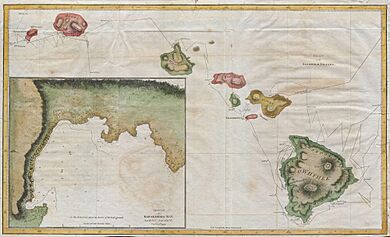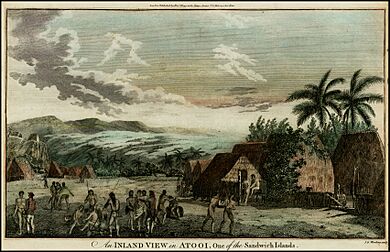Third voyage of James Cook facts for kids
Captain James Cook's third and final journey (from July 12, 1776, to October 4, 1780) was a British effort to find the Northwest Passage. This was a sea route connecting the Atlantic Ocean to the Pacific Ocean, across the top of North America. The expedition did not find the passage, and sadly, Captain Cook died in Hawaii during a conflict with the local people.
The main public reason for this voyage was to take Omai, a young man from Raiatea, back to his home island. However, the British Admiralty (the group in charge of the British Navy) secretly planned for Cook to search for the Northwest Passage. Two ships were prepared: HMS Resolution, commanded by Captain Cook, and HMS Discovery, led by Charles Clerke. The journey began from Plymouth, England, in 1776.
After Omai was safely returned home, the ships sailed into the central Pacific. There, they discovered the Hawaiian Archipelago, which Europeans had not known about before. They then continued to the Pacific coast of North America. After exploring and mapping the northwest coast, they sailed through the Bering Strait into the Arctic Ocean. However, thick pack ice blocked their way. The ships turned back to the Pacific, stopping briefly at the Aleutian Islands. Captain Cook then decided to return to the Hawaiian Islands for the winter.
At Kealakekua Bay, off the island of Hawaii, tensions grew, leading to conflicts between the Europeans and Hawaiians. On February 14, 1779, Captain Cook died during one of these clashes. Charles Clerke took command of the expedition. He made another attempt to find the Northwest Passage but also failed before he passed away from tuberculosis. Under the leadership of John Gore, the crews finally returned to London in October 1780.
Captain Cook's Final Journey
The Quest for the Northwest Passage
Captain Cook's orders from the British Admiralty were inspired by a law from 1745. This law, updated in 1775, promised a large prize of £20,000 to anyone who discovered the Northwest Passage. At first, the Admiralty wanted Charles Clerke to lead the trip. Cook, who was retired after his earlier Pacific adventures, was asked to be a consultant. However, Cook had studied earlier expeditions by Vitus Bering. So, the Admiralty decided to trust the experienced explorer, Cook, to lead the voyage, with Clerke joining him. The plan was for two groups to search: Cook from the Pacific side near the Bering Strait, and another ship, the Lyon, from the Atlantic side. They hoped to meet in the summer of 1778.
In 1773, Omai, a young man from Raiatea, traveled to Europe. He had met Captain Cook's second voyage crew in Tahiti. Omai arrived in London in 1774 and became quite famous, introduced to society by a scientist named Sir Joseph Banks. The public believed that the third voyage's main goal was to take Omai back to his home. This was a good cover story for the secret mission to find the Northwest Passage.
Preparing for the Adventure
Ships and Supplies
For his last voyage, Captain Cook once again commanded HMS Resolution. This ship started as a coal transport vessel in 1770. The Royal Navy bought it in 1771 and changed it for exploration. It was about 34 meters (111 feet) long and 11 meters (35 feet) wide. After returning to Britain in 1775, it was prepared again for Cook's third voyage in 1776. The Resolution carried many gifts from George III for the people of the South Sea Islands. These included sheep, cattle, goats, pigs, and various types of poultry. Cook also ordered a large amount of clothing for the crew, like jackets, waistcoats, shirts, and shoes.
Captain Charles Clerke commanded HMS Discovery. This ship was also a coal transport vessel, built in 1774. It was smaller, about 9 meters (27 feet) wide. The Admiralty bought it for £2,415. Originally a brig (a ship with two masts), Cook had it changed into a full-rigged ship (a ship with three or more masts).
The Brave Crew Members
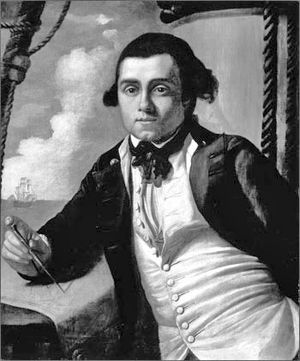
On the Resolution, Cook's first officer was John Gore. Gore had already sailed around the world with Cook on the Endeavour. James King was the second officer, and John Williamson was the third. The ship's master was William Bligh, who later became famous for commanding HMS Bounty. William Anderson was the surgeon and also studied plants. The artist John Webber was the official painter for the voyage. The crew included six midshipmen, a cook, quartermasters, marines, and many skilled sailors.
The Discovery was led by Charles Clerke. He had also been on Cook's first two expeditions. His first officer was James Burney, and among the midshipmen was George Vancouver, who had sailed with Cook before. The Discovery had a crew of 70 people, including officers, sailors, marines, and one civilian.
Other notable crew members included:
- William Bayly, the astronomer.
- Joseph Billings, a sailor who served on both ships.
- John Ledyard, an American marine.
- David Nelson, who collected plants.
- Omai, the native of Raiatea, who helped as an interpreter until he returned home.
- Nathaniel Portlock, a master's mate.
- Henry Roberts, who helped create the maps for the voyage's official report.
- David Samwell, the surgeon's first assistant on the Resolution.
Exploring New Horizons
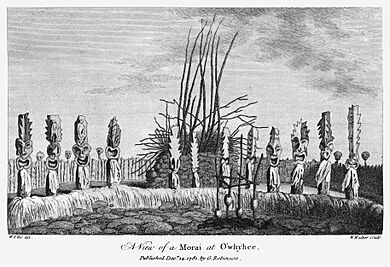

From Africa to the Pacific
Captain James Cook left Plymouth on July 12, 1776. The Discovery, with Clerke, left a bit later on August 1. On the way to Cape Town, the Resolution stopped at Tenerife for supplies. The ship reached Cape Town on October 17. Cook had to repair the ship because it was leaking badly. When the Discovery arrived on November 10, it also needed repairs.
The two ships sailed together on December 1. They found and named the Prince Edward Islands on December 13. Twelve days later, Cook found the Kerguelen Islands, which he had missed on his second voyage. Strong winds pushed them to Van Diemen's Land (now Tasmania) on January 26, 1777. There, they got water and wood and met the local Aboriginal people. The ships then sailed to Queen Charlotte Sound in New Zealand, arriving on February 12. The Māori were cautious because they remembered a past conflict. After two weeks, the ships left for Tahiti. Strong winds took them to Mangaia first, sighted on March 29. To get more supplies, they sailed to the Friendly Isles (now Tonga), stopping at Palmerston Island along the way. They stayed in Tonga from April 28 until mid-July, then headed to Tahiti, arriving on August 12. They stayed there for several weeks to trade and resupply. In October 1777, Cook explored Moʻorea. This was the first time the islanders met Europeans. During their stay, one of Cook's goats was stolen. After talks failed, armed groups went ashore. Eventually, the goat was returned, and Cook left Mo'orea.
Discovering the Hawaiian Islands
After returning Omai to his home, Cook continued his journey north on December 7. On January 18, 1778, he became the first European to visit the Hawaiian Islands. After landing at Waimea harbor on Kauai, Cook named the islands the "Sandwich Islands" after the fourth Earl of Sandwich, a leader in the British Navy. The explorers noticed that the islanders spoke a language similar to other Polynesian languages they had heard in the South Pacific. On January 20, 1778, a disagreement occurred, and sadly, a local person lost their life during a confrontation when islanders tried to board the small boats.
Mapping North America's Coast
From Hawaii, Cook sailed northeast on February 2 to explore the west coast of North America. He landed on March 6 near Cape Foulweather on the Oregon coast, which he named. Bad weather pushed his ships south before they could start exploring northward. He sailed past the Strait of Juan de Fuca without knowing it was there. Soon after, he entered Nootka Sound on Vancouver Island. He anchored near the First Nations village of Yuquot. Cook's ships stayed in Nootka Sound for about a month, from March 29 to April 26, 1778. The relationship between Cook's crew and the people of Yuquot was friendly, though sometimes tense. The people of Yuquot wanted valuable metal items in trade, not just the small trinkets that had worked in Hawaii. Sea otter pelts were the most valuable items the British received. During their stay, the Yuquot people largely controlled the trade.
After leaving Nootka Sound, Cook explored and mapped the coast all the way to the Bering Strait. He identified what is now known as Cook Inlet in Alaska. It is said that in this single visit, Cook charted most of the North American northwest coastline for the first time. He also helped define the size of Alaska and connected the maps made by Russian and Spanish explorers.
Into the Arctic Ice
By the second week of August 1778, Cook had passed through the Bering Strait and was sailing into the Chukchi Sea. He headed northeast along the coast of Alaska until thick sea ice blocked his path at 70°44′ north latitude. Cook then sailed west to the Siberian coast, but again, ice prevented him from going further at a point he called Cape North (now Cape Schmidt). He then followed the Siberian coast southeast back to the Bering Strait. By early September 1778, he was back in the Bering Sea to begin the trip to the Hawaiian Islands. During this part of the voyage, Cook became increasingly frustrated. He may have been suffering from a stomach illness, which some believe led to him acting unusually towards his crew. From the Bering Strait, the crews sailed south to Unalaska in the Aleutian Islands. Cook stopped there on October 2 to repair the ship's leaking timbers again. During their three-week stay, they met Russian traders and learned about the local people. The ships left for the Hawaiian Islands on October 24, sighting Maui on November 26, 1778.
The two ships sailed around the Hawaiian Archipelago for about eight weeks, searching for a good place to anchor. They finally landed at Kealakekua Bay, on the west coast of Hawaii Island, on January 17, 1779. As they sailed around the islands, many canoes filled with gifts approached the ships, and the occupants fearlessly came aboard. A chief named Palea and a priest named Koa'a came aboard. They formally escorted Cook ashore, where he took part in a long and special ceremony before returning to his ship. Cook did not know that his arrival happened during the Makahiki, a Hawaiian harvest festival to honor the god Lono. Coincidentally, the shape of Cook's ship, HMS Resolution—especially its masts, sails, and ropes—looked like important items used in the festival. Also, Cook's clockwise route around Hawaii Island before landing was similar to the processions during the Lono festivals. Some people believe these coincidences led some Hawaiians to treat Cook as a god, an incarnation of Lono. However, this idea has been debated.
A Tragic End in Hawaii
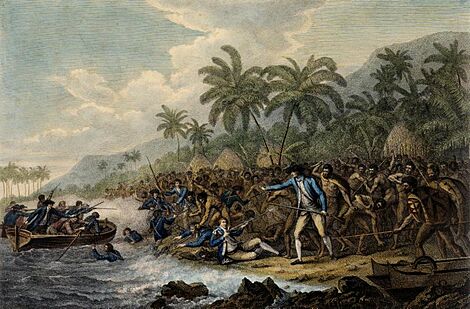
After staying for a month, Cook prepared to continue exploring the Northern Pacific. However, shortly after leaving Hawaii Island, the front mast of the Resolution broke. The ships had to return to Kealakekua Bay for repairs. It is thought that the Hawaiians did not expect or welcome the expedition's return, especially since the Lono festival season had recently ended. In any case, tensions grew, and several conflicts broke out between the Europeans and Hawaiians. On February 14, at Kealakekua Bay, some Hawaiians took one of Cook's small boats. Usually, when things were stolen on other islands, Cook would take important people hostage until the stolen items were returned.
Cook tried to take Kalaniʻōpuʻu, the King of Hawaiʻi, as a hostage. However, the Hawaiians realized Cook's intentions and raised an alarm. King Kalaniʻōpuʻu stopped and sat down. Before Cook could force the king to move, hundreds of Hawaiians, some armed, appeared and became angry. Cook's men had to retreat to the beach. As Cook turned to help launch the boats, he was struck and then died in the water. Hawaiian tradition says a chief named Kalanimanokahoowaha killed him. The Hawaiians took his body away. Four marines also died, and two others were injured in the conflict.
Despite the conflict, the Hawaiians respected Cook. Their chiefs and elders kept his body. Following the customs of the time, Cook's body underwent special rituals, similar to those for important leaders in their society. Some of Cook's remains were later returned to the British crew for a formal burial at sea, after the crew asked for them.
The Journey Home
Charles Clerke, who was very ill with tuberculosis, took command of the expedition. Sailing north, he landed on the Kamchatka Peninsula in Russia, where the Russians helped with supplies and ship repairs. He made one last attempt to pass beyond the Bering Strait but died on his return at Petropavlovsk on August 22, 1779. From there, reports of the ships' journey were sent overland and reached London five months later. After Clerke's death, the Resolution and Discovery turned for home. John Gore, who had been on Cook's first voyage, now commanded the expedition, with James King leading the other ship. After sailing down the coast of Japan, they reached Macau, China, in early December. From there, they followed the East India trade route through the Sunda Strait to Cape Town.
Return Home
An Atlantic storm blew the expedition far north, and they first landed at Stromness in Orkney, Scotland. The Resolution and Discovery arrived off Sheerness, England, on October 4, 1780. News of Cook's and Clerke's deaths had already reached London, so their return was a quiet one.
See also
 In Spanish: Tercer viaje de James Cook para niños
In Spanish: Tercer viaje de James Cook para niños




